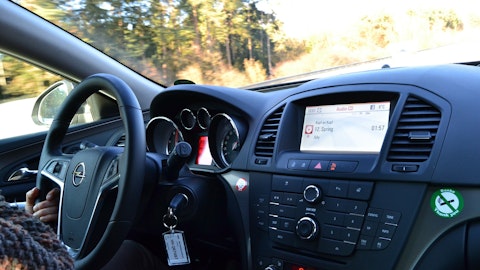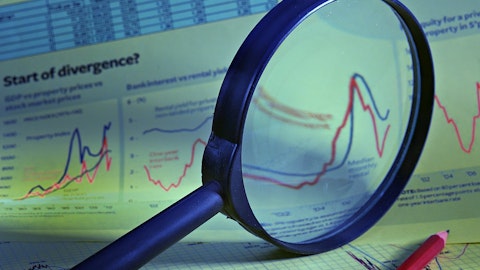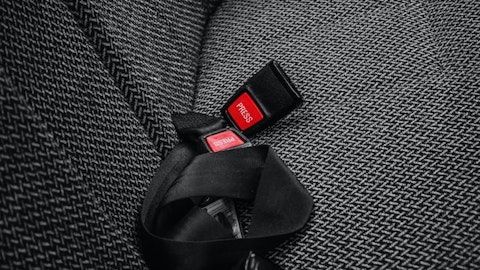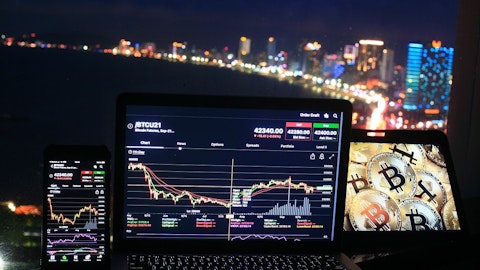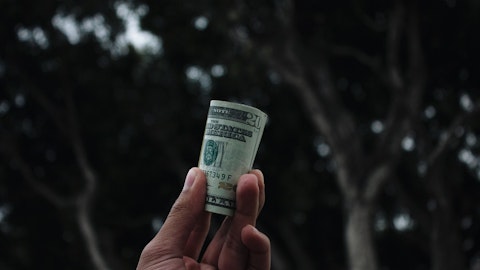Autoliv, Inc. (NYSE:ALV) Q1 2023 Earnings Call Transcript April 21, 2023
Anders Trapp Thank you, Rafiya. Welcome everyone to our first quarter 2023 earnings call. On this call, we have our President and CEO, Mikael Bratt; and our Chief Financial Officer, Fredrik Westin, and [indiscernible] I am the, VP of Investor Relations.During today’s earnings call, Mikael and Fredrik will, among other things, provide an overview of the strong sales development in the first quarter, discuss operating leverage and outline the expected sequential margin improvement for 2023, as well as provide an update on our general business and market conditions. We will then remain available to respond to your questions, and as usual, the slides are available at autoliv.com.Turning to the next slide, we have the Safe Harbor statement, which is an integrated part of this presentation, and of course, includes the Q&A that follows.During the presentation, we will reference some non-U.S. GAAP measures.
The reconciliations of historical U.S. GAAP to non-U.S. GAAP measures are disclosed in our quarterly press release available on autoliv.com and in the 10-Q that will be filed with the SEC.Lastly, I should mention that this call is intended to conclude at 03:00 PM Central European Time. So, please follow a limit of two questions per person.I will now hand over to our CEO, Mikael Bratt.Mikael Bratt Thank you, Anders. Looking on the next slide. I would like to start by thanking our employees for a good execution, supporting our strong growth in a challenging environment. The sales performance and strong profit recovery was in line with our earlier communicated expectations. Thanks to a strong ending of the quarter, our organic sales grew by more than 20% outperforming light vehicle production significantly.
The strong growth was a result of product launches, higher prices, and higher safety content per vehicle and also supported by a positive regional mix.Our profit development was as expected considering that market conditions continued to be challenging, especially in Europe with significant inflationary pressure and continued customer pool of volatility. Mainly due to strong sales [indiscernible] adverse working capital development led to negative cash flow in the quarter. We expect a [indiscernible] cash flow trend for the rest of the year. Our leverage ratio increased to 1.6 times to 1.4 times three months ago. In the quarter, we paid $0.66 per share in dividends and repurchased and retired 450,000 shares.We issued our first green bond that allows us to reach new investors and at the same time help fund advancement of our climate targets.
We have a strong commitment to climate actions and this is a milestone in supporting our customers in achieving their sustainability ambitions.We are expanding to Vietnam, investing in increased production capacity of airbags, cushions in Asia for Asia. We saw updates to crash test standards and safety regulations in the U.S. and in India, which will support continued increase in safety content per vehicle already this year as well as coming years. We also continue to look for ways to improve our footprint and reduce our costs structurally. The first quarter development [indiscernible] and we continue to expect a gradual improving adjusted operating margin during the year. This should allow us to reach the full year indications we set at the beginning of the year.Now looking at the expected adjusted operating margin progression for 2023 on the next slide.
For 2023, we expect a gradual improvement of the adjusted operating margin quarter-by-quarter, similar to the trajectory in 2022. We expect continued high sales growth supported by launches, higher light vehicle production and content per vehicle increase. We anticipate price adjustments will gradually throughout the year offset cost inflation that affect us in the first quarter.The positive trajectory will be further supported by improvements from cost reductions, footprint optimization, as well as expected gradual improvement of the supply chain and light vehicle production stability. FX are limited in the first half of the year and significantly larger in the second half of the year.[Indiscernible] makes me confident in a gradual improving performance, which should allow us to deliver a significant full year increase in cash flow and adjusted operating income.Looking now on our sales growth in more detail on the next slide.
Our consolidated net sales increased by US$2.5 billion, a record for the first quarter. This was close to US$317 million or 17% higher than a year earlier, despite $77 million or four percentage point’s currency headwind. Price volume mix contributed with $444 million.Looking on the regional sales split, Asia accounted for 38%, Americas was 33% and Europe was 29%. The China share decreased from 21% a year ago to 18% now as light vehicle production grew in all regions in the quarter, except in China, where it declined significantly. We outlined our organic sales growth compared to light vehicle production on the next slide.I am very pleased that our organic sales growth significantly outperformed global light vehicle production growth in the first quarter.
This was achieved as we continued to execute on our strong order book. According to S&P Global, light vehicle production increased by around 6% year-over-year in the quarter. This was slightly higher than expectations in the beginning of the quarter. Based on the latest light vehicle production numbers, we outperformed global light vehicle production by around 15 percentage points in the quarter.In the quarter, we outperformed in Japan by 17 percentage points, in China by 16 percentage points and in Europe by 14 percentage points. Compared to the fourth quarter last year, light vehicle production in the first quarter fell by around 4%. Despite this, our sales increased by 7% sequentially, supported by new launches, market share gains and content per vehicle growth.
We expect these positive sales trend to continue, and we expect to outperform light vehicle production by around 12 percentage points for the full year 2023.Looking now on financials in more detail on the next slide. The strong sales increase led to a substantial improvement in adjusted operating income, including effects of capacity alignment and antitrust-related matters, which increased from $68 million to $131 million. The adjusted operating margin was 5.3% in the quarter, an increase of 2.1 [ph] percentage points from the same period last year.Operating cash flow was negative $46 million, which was $116 million lower than the same period last year, mainly from adverse working capital as an effect of significantly higher sales level towards the end of the quarter.
Fredrik will provide further components of cash flow later in the presentation.On the next slide, we see some key model launches from the first quarter. In the quarter, we had a high number of product launches, especially in China and Europe. The models shown on this slide have an Autoliv content per vehicle from approximately $140 to close to $550. These models reflect the changes seen in the automotive industry in the recent years, with several relative new OEMs represented and that six out of nine [indiscernible] as pure EV.In terms of Autoliv sales potential, the Subaru launches are the most significant. The long-term trend to higher content per vehicle is supported by front center airbag, more advanced seatbelt and pedestrian protection airbags.I will now hand it over to our CFO, Fredrik Westin, who will talk about the financials on the next few slides.Fredrik Westin Thank you, Mikael.
This slide highlights the key figures for the first quarter of 2023 compared to the first quarter of 2022. Our net sales were $2.5 billion this was 17% higher than the first quarter of 2022. The gross profit increased by 32% to $379 million, while the gross margin increased to 15.2%. The gross profit increase was primarily driven by price increases, volume growth and lower costs for premium freight.In the quarter, we made $4 million in provisions for capacity alignment activities and antitrust-related matters. The adjusted operating income increased from $68 million to $131 million. The adjusted operating margin increased from 3.2% to 5.3%. We do recognize that the operating leverage on the strong sales growth was limited in the quarter, and I will explain more when we go through the operating income bridge.The operating cash flow was negative $46 million.
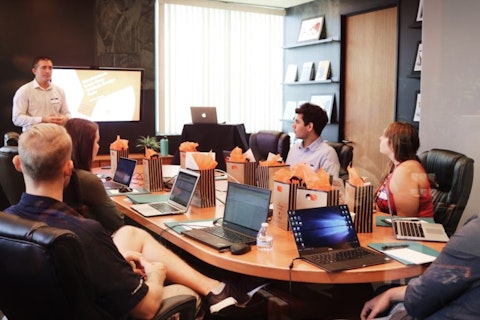
Photo by Campaign Creators on Unsplash
Earnings per share diluted decreased by $0.08, where the main driver was $0.52 from capacity alignments and $0.05 from taxes, partly offset by $0.51 from higher adjusted operating income.Our adjusted return on capital employed and return on equity increased to 13% and 12% respectively. We paid a dividend of $0.66 per share in the quarter, and repurchased and retired around 450,000 shares for $42 million under our stock repurchase program.Looking now on the adjusted operating income bridge on the next slide. In the first quarter of 2023 our adjusted operating income of $131 million was $63 million higher than the same quarter last year. The impact of raw material price changes was negative $12 million in the quarter. Foreign exchange impacted the operating profit negatively by $25 million; this was mainly a result of [indiscernible] translation effects from the Mexican peso.Costs for SG&A and RD&E, net combined was $26 million higher mainly due to higher personal costs and projects.
Operations were positively impacted by improved pricing, higher volumes, lower costs for premium rate as well as our strategic initiatives partly offset by the significant headwinds from general cost inflation. The impact of the strong sales growth was relatively low in the quarter as new product launches have a lower operating leverage initially. As a result, the leverage on the higher sales excluding currency effects was in the low-end of our typical 22% operational leverage range. The actions we are now taking that Mikael talked about previously should lead to significantly higher operating leverage, profitability and cash flow as the year progresses very much like last year.Looking now on the cash flow on the next slide. For the first quarter of 2023, operating cash flow decreased by $116 million to a negative $46 million due to higher working capital and lower net income.
During the quarter trade working capital increased by $226 million essentially from higher receivables. The higher receivables was a result of high sales towards the end of the quarter. The inefficiencies in inventories did not materially improve as light vehicle production continued to be volatile.For the first quarter capital expenditures, net increased to $143 million from $17 million in the previous year’s quarter. The first quarter last year was positively affected by the sales of a property in Japan for $95 million. Excluding the property sale, CapEx in relation to sales this quarter increased to 5.7% from 5.3% a year ago. The current high level of investment is related to the ongoing footprint activities and capacity expansion for growth, especially in China.
For the first quarter of 2023, free cash flow was negative $189 million; $242 million lower than a year earlier. Although our cash flow was temporarily weaker in the first quarter, we expect a gradual positive cash flow development for the rest of the year from higher net income and a more stable sales level. Our full year indication is for an operating cash flow of $900 million and that is unchanged.Now looking on our leverage ratio development on the next slide. The leverage ratio at the end of March 2023 was 1.6 times. This was 0.2 higher than in the previous quarter at the net debt increase proportionally more than the 12 months trailing adjusted EBITDA increased. We do remain committed to our 2022 to 2024 share repurchase program, and as you know, we are considering several factors when executing the program.
As we have mentioned many times, we are not only considering the debt leverage ratio when deciding on the pace of the repurchases, we’re also considering our balance sheet, cash flow outlook, the debt rating and the general business outlook. We’re always strive for the balance that is best for our shareholders both long and short-term.Now looking at the next slide, sustainability is integrated into everything we do by reducing the number of road fatalities and making transportation systems safer for everyone, our core business directly contributes to the United Nations Sustainable Development Goals, STGs. During the first quarter, we successfully issued a first €500 million green bond using Autoliv’s sustainable financing framework aligned with the EICMA green bond principles.
The issuance drew significant interest from debt investors leading to a successful pricing of the bond, resulting in a coupon of 4.25%. The proceeds of our first green bond used exclusively for financing green projects including clean transportation, renewed energy, energy efficiency and de-carbonization of operations and products. With a projects financed by the green bond we believe we can further contribute to sustainable society.Now looking at the liquidity position onto the next slide; at the end of the quarter, we had a strong liquidity position with approximately $1.8 billion in cash and unutilized committed credit facility. With a sustainable financing framework we have diversified our long-term funding sources. We also have a maturity profile that is well spread out over the coming years.
Note that none of our credit facilities are subject to financial covenants. With a leverage ratio of 1.6 times, our BBB S&P rating with stable outlook, a balanced maturity profile and the strong liquidity position, we are well positioned to operate in any environment.I’ll now hand it back to you, Mikael.Mikael Bratt Thank you, Fredrik. Let’s look market environment and financial outlook for 2023 on the next few slides. Due to supply constraints of semiconductors, large part of the auto industry have been operating at or near recessionary levels. As the supply of semiconductors has improved somewhat, S&P Global has upgraded the near-term light vehicle production forecast.For second quarter, global light vehicle production is now expected by S&P Global to improve by 13% compared to last year.
Compared to the first quarter, volumes are expected to be about unchanged. Despite concerns surrounding elevated vehicle pricing in some markets and deteriorating credit conditions, global production is corrected to increase by [indiscernible] to close to $83 million in 2023, according to S&P Global.The Chinese market remains volatile short term due to the discontinuation of last year’s lower purchase tax and the introduction of new emission rules leading to destocking of inventories at the dealerships. Light vehicle production in North America is projected by S&P to increase by more than 5% in 2023. However, due to recessionary figures, an increasing inventory levels, the forecast for second half of 2023 has been revised lower. S&P outlook for European light vehicle production has increased by 300,000 units.
However, we remain cautious regarding European vehicle demand for 2023. Looking at the 2023 financial indication on next slide.Our full year 2023 indications are unchanged and exclude costs and gains from capacity alignment, antitrust-related matters and other discrete items. Our full year indication is based on light vehicle production growth assumption of around 3%. We expect sales to increase organically by around 15%. Currency translation effects are assumed to be around negative 1%. We expect an adjusted operating margin of around 8.5% to 9%. Operating cash flow is expected to be around $900 million. Our positive cash flow trend should allow for increasing shareholder returns.Turning to the next slide. I am looking forward to seeing you at our Investor Day, which will be held on Monday, June 12 at our technology center in Auburn Hills, Michigan, U.S. The focus of the event will be on medium- and long-term growth opportunities, world-leading products, our strategic road map as well as our innovation wins in optimization and operation efficiency and what progress we are making.
The format is a half day with presentations by members of our executive management team and exhibitions of Autoliv’s latest innovation and technologies showcased by subject matter experts. I’m looking forward to seeing many of you there.Turning to the next slide. This concludes our formal comments for today’s earnings call, and we would like to open the line for questions. I will now turn it back to Rasala.
See also 15 Biggest Mutual Fund Companies in the World and 11 Best Waste Management Stocks to Buy Now.
Question-and-Answer Session Operator Thank you, sir. [Operator Instructions]
Thank you. We are now going to proceed with our first question. The question is come from the line of Colin Langan from Wells Fargo. Please ask your question. Your line is open. Colin Langan Great. Thanks for taking my questions. Just in terms of the labor cost recoveries, any framing of any impact in Q1?
And then I think in the past, you’ve kind of given an update of what sort of percent of contracts you’ve been able to renegotiate. Any sort of color there on how that’s trending in Q1 and so far in Q2?Mikael Bratt When it comes to the price negotiations, I would say it’s too early at this point to start to give you an indications on bridge [ph]. I would say that it’s in relation to the full year expectations here on the price adjustments; we are in the early stage here. And I would say it is a limited impact, but it is an impact in line with our expectation [indiscernible] in time. So what I would like to say here is that we’re making the progress we need to do to support our confidence when it comes to for the full year here. But it’s not meaningful to give a percentage points at this point – at this point in time in and the contracts connected to labor.Colin Langan Got it.
And during the quarter, steel prices have jumped quite a bit. Can you just remind us sort of what your risk would be? And because I know you’ve changed the way your contracts are structured. So are there triggers that renegotiate this, I believe, or any risk there to the outlook from that jump in steel prices?Fredrik Westin No, you’re right. We have also seen that the steel prices have now turned upwards again in certain areas. So that means that we – whereas we were initiate [ph] a quarter ago, we’re expecting actually to have a positive effect on the – from steel prices on us. For the full year, we now expect that to be more or less flat with the outlooks that we have here. We have indicated that we have now a better balance of how we’re set up versus our suppliers and then our customers that we should be able to manage this and not have any significant impact on profitability from this development.Colin Langan Okay.
Any color on the percent of contracts that have sort of clauses that trigger renegotiation? I thought in the past, you said something like 90% and maybe I’m misinterpreting that.Fredrik Westin No, we said that we had to close more than 90% of the negotiations related to raw materials. And that we are now roughly half of our business on the sales side – on the customer side now has an indexation type of setup that would adjust for raw material fluctuations. And steel has a larger part than other commodities.Colin Langan Great. Thanks for taking my questions.Mikael Bratt Thank you. Operator We’re now going to proceed with our next question. And the questions come from the line of Emmanuel Rosner from Deutsche Bank. Please ask your question.Emmanuel Rosner Thank you very much.
Just a fairly specific question here on a piece of your operating income bridge on Slide number 10. It seems like currency was a fairly large headwind. It seems like a meaningful portion of – as a percentage of last year operating income, but obviously, a much smaller impact on the revenue side, which is only a few percent. So can you just go over what’s happening there on the FX side? Because it seems like excluding that, I think your margins would have been somewhat meaningfully better.Fredrik Westin Yes. So, we’re showing here year-over-year effect of negative $25 million. We’re close to $20 million of that is from transactional currency effects and the translational and then the revaluation parts are smaller also both [indiscernible] about $2 million each.
And so the negative impact is from the appreciation of the Peso against the U.S. dollars. That’s roughly two-thirds of the negative transactional effects, but we also have negative effects on a year-over-year basis still from the U.S. dollar, Japanese yen and also U.S. dollar Korean won. They have improved sequentially, but they have still on a year-over-year view here, they also have a negative impact for us.Emmanuel Rosner Okay. And any thoughts on the – in your outlook, is that a meaningful contributor in the full year?Fredrik Westin No, we – full on FX, we do indicate here that on the revenue side, we still see the negative 1% and then how all the currency payers [ph] of payout over the year we’ll see. I mean we, of course, do expect the currency rates stay where they are that in the second half of the year, we should have a pretty favorable effect from the Asian currencies against the dollar.
